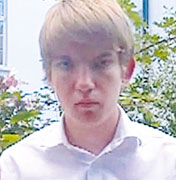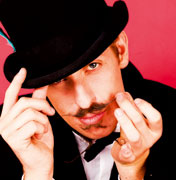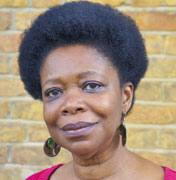Now that’s MAGIC!
By wand or wit, a skilled magician can upend our established assumptions about the way the world works, making us literally not believe our eyes. This doubt is the power of magic. But this doubt is also the audience’s reward, a reminder of the pleasure of uncertainty and the virtue of suspended disbelief.
Magic seems to tell us that the real danger is not in appearing to consort with the Devil or bend the laws of nature, but in thinking that we already know all there is to know. Here, the fantastic four show their hands.
 SOPHIE CORDWELL JAMES
SOPHIE CORDWELL JAMES Sophie is part of a group of four female magicians called Chicks ’n’ Tricks. After studying collaborative performing arts at university, she auditioned for the group and her magic skills developed from there.
‘We’re fortunate because there aren’t many female magicians, so as a four-strong group of young women we have a niche in the market. Sometimes people don’t expect us to be that good because we’re female. They come in with low expectations, so if you’re good, which we are, you get to wow them even more. I think it works in our favour massively.
‘The best thing is wowing people; the reaction you get is like nothing else. When you look at the audience you can see that they can’t believe what you’ve just done. You get this automatic respect.
‘My top tips for anyone wanting to get into magic would be to read books on the subject, watch DVDs, find magicians who impress you and the style of magic you like. Take in as much knowledge as you can and then practise, practise, practise.’
 CAMERON DURDY
CAMERON DURDY Sixteen-year-old Cameron has been performing card sleights since 2011. He honed his skills in his free time after school exams.
‘I started doing tricks when I was 13, bringing cards into school. I knew one trick and performed it for some friends. When I got good reactions, I thought “Ooh, this is nice”, so I learnt some more and it spiralled from there. I fell in love with performing.
‘I started learning by watching videos on the internet, but a family friend is a magician and he told me to learn from books. So I bought lots of books and studied them. I’ve amassed a small library.
‘I like to study the way people do things and react to things. My tricks are more psychological now. I learnt to study people and to try to figure out what’s going to happen; my mum is a psychologist, which helps. A good example of how psychology comes into my magic is the card trick. I might say “seven of spades” in a quiet voice before asking the participant to “think of a card” in my normal voice. I lower my voice and my body language will have shrunk in, so you won’t pay as much attention to me, but “seven of spades” rings in your mind because I’ve planted it there.
‘The difference between tricks and magic is that magic has supernatural connotations. I don’t believe in ghosts or devils. For me it doesn’t feel right, when I don’t believe magic exists, to try to convince my audience it does. It feels like a lie. But if people want to believe it’s magic and I tell them it’s sleight of hand, they are disappointed. So I let the trick do the talking and then they can draw their own conclusions.
‘I enjoy the audience’s reaction and how much they enjoy the tricks. It’s a selfish thing, but I also just love the technique: the sleight of hand, the fact I’ve done this difficult move that’s taken me six months to get right. And I can do it and all these people can’t. That gives me a lot of pleasure.’
 CHARLES RAY
CHARLES RAYCharles was originally a dancer, but his career was brought to a sudden end when he had an accident while working as a ticket collector for a tourist train in Bournemouth. The train went out of control, running him over and crushing his pelvis. Still keen to perform, he took up magic and eventually found himself entertaining at Hugh Grant’s 50th birthday party.
‘After my accident, I tried a lot of jobs and eventually got one at Hamleys selling magic. I realised how easy it was for me as a dancer because magic is just dancing with your hands. I trained myself by watching YouTube videos and talking to other magicians, then quit my job.
‘When I have a new trick, I practise it at least 100 times before a professional show. It can take up to 10 hours to learn a new trick, and until you’ve done it in front of people loads of times you don’t know what their reaction will be. Some things I’ve shown magicians and they say it’s amazing, but I show the public and they say so what. People fall for tricks I never thought they’d be fooled by. Even as an experienced magician, there are still things I don’t understand.
‘Hugh Grant is a cool guy and he was really encouraging. We got on really well; he was the perfect person to perform for. I love doing a job that has a positive impact on the world. It’s my job to facilitate people’s happiness, to take a room and be the catalyst that creates joy. I can open their eyes to the possibility that reality isn’t quite as it seems.
‘I’ve had a lot of jobs in sales and I always found something about the product that made me not want to sell it. As a magician I’m paid to lie. It’s ironic that I’m professionally lying to people but it’s the only job I’ve ever had when it’s completely OK to do it.’
 JENNY MAYERS
JENNY MAYERS Out of 1,500 people in The Magic Circle, only 80 of them are women, of which Jenny Mayers is one. She is also the circle’s first Caribbean female member.
‘I just hope a few more women join The Magic Circle. I’m not sure if it’s hard for them to get into magic or if women just aren’t interested in it. On my tours, when I work with women, they say the magic is clever, but when you ask them to take part, more often than not the men will jump in and the women won’t.
‘I think it’s a confidence thing. Women think they can’t do it. But they can if they try.
‘I like the mysteriousness of it. But it’s also innocent and it’s clever, like when you work hard on a maths problem and then all of a sudden it clicks in your head.
‘Also, the look of astonishment on people’s faces when you do a trick and it makes someone’s day. Seeing someone enjoy what I’ve done makes me really happy.’
Illustrations taken from Magic: 1400s-1950s, by Mike Caveney, Jim Steinmeyer, Ricky Jay and Noel Daniel. The book has a hardcover in a slipcase, sized 10in x 15in (544 pages), and is published by TASCHEN, priced £44.99. It is available from TASCHEN Store, 12 Duke of York Square, London SW3.


